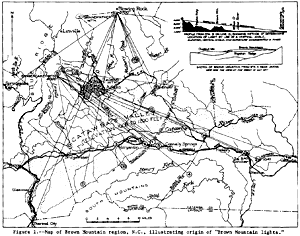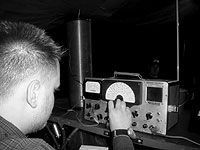These are hard times for unexplained phenomena. Daily, one by one, the old myths are being teased apart by the icy hand of science. Crop circles: yawn; the Loch Ness Monster: likely a pile of fog-wreathed hooey; spontaneous human combustion: yesterday’s news. Even if you have proof that Great Aunt Lila was consumed by mysterious flames — say, the telltale spot of grease where her swollen ankles used to be — the “experts” would no doubt have some findings involving a spark, a surfeit of hairspray or an acetate brassiere.

Following the highway signs is much easier: This map of the Catawba Valley shows the location of the Brown Mountain Lights, first documented by a German explorer in 1771.
|
So what, then, explains the enthusiasm for the Brown Mountain Lights, the glowing orbs said to shine and dance along a local ridge top? Well for one, they’re a lot easier to get to than Scotland. And two, a lot of people insist that they’ve really, truly seen them. So many, in fact, that this year a festival has been named in their honor.
This Friday, June 9, begins the first annual Brown Mountain Lights Festival, a three-day celebration of the South’s favorite unearthly effulgence. The event will bring to the otherwise sleepy hamlet of Linville Falls a host of speakers, folklorists, musical acts, and craft and food vendors. Both Friday and Saturday will be crowned by nighttime excursions to Wiseman’s View, a favored observation point near the summit of Linville Mountain. Who knows? You may see them.
A brief and [mostly] true history
“It’s hard to walk around here without stumbling into someone who’s seen the lights,” says Christopher Blake, one of the festival’s organizers. “However,” he adds, “I’ve never seen them myself.”

Measuring a mystery: Joshua Warren of the League of Energy Materialization and Unexplained phenomena Research has offered a scientific explanation for the Lights.
|
Blake’s suspension of disbelief in service of a good time fits neatly with what he hopes will be the spirit of the festival: a chance for believers, skeptics and the just plain curious to come together in celebration of a genuine nugget of Tarheel lore.
“We insist on that kind of diversity,” says Blake. “It should be quite an intriguing mix.”
First word of mysterious lights atop Brown Mountain, a 2,600-foot ridge that splits Burke and Caldwell counties, comes down to us from the Cherokee. A major battle between the tribe and its neighbors, the Catawbas, was said to have taken place along the ridge, and the spirits of those who fell are believed to still wander its slopes, visible as points of light. Another, more recent, explanation has to do with an escaped slave carrying a lantern along the ridge.
In 1771 an obscure German sojourner named Gerard Will de Brahm described the mechanism behind the lights as “nitrous vapors which are borne by the wind and when laden winds meet each other the niter inflames, sulphurates and deteriorates.” Theories like de Brahm’s, and others involving explosive, malodorous gases, still have their adherents, especially within the 12-year-old-male demographic.
Other explanations for the Brown Mountain Lights have involved magnetic variances, ball lightning, and St. Elmo’s Fire, the discharge of electrical current from conductive objects.
Settlers along the Blue Ridge, and their descendants, kept the stories alive. In 1913, the Charlotte Observer printed an article asserting their existence, despite the fact that “those members of the Morganton Fishing Club who first saw it more than two years ago were laughed at and accused of ‘seeing things at night’ as a result of a common human frailty.”
Whether one is sober or not, the Brown Mountain Lights mystery is so compelling that in 1999 it framed an episode of the X-Files, wherein agents Scully and Mulder traveled to North Carolina to examine some skeletons found at the selfsame mountain. The episode’s premise was that the lights had the dastardly effect of luring humans into caves beneath the mountain, there to be fed upon by hallucinogenic spores, which, after doping their victims, turned their bodies into so much goo. Like, OK, whatever.
Mysterious lights like Brown Mountain’s make up one of the largest categories of unexplained phenomena, by some counts more popular than bleeding Christ figures, apparitions of the Virgin Mary, and storms of falling fish. Most famous in the United States are the Marfa Lights in sere and cattle-strewn West Texas. The types of light peculiar to Brown Mountain have taken on a variety of forms, from small pinpoints to basketball-sized circles that split apart, rejoin and change color from red, to white, to blue. (Which, if not plausible, are at least patriotic.)
Hallelujah, they saw the lights
Asheville paranormal expert Joshua Warren of L.E.M.U.R. (League of Energy Materialization and Unexplained phenomena Research) has spent many a night gazing at Brown Mountain’s undulating flanks, looking for sign of lights. But unlike most visitors to the site, Warren and his team have brought with them an assemblage of meters and counters and infrared sensors and other devices that would make an Apollo mission blush. The results of their study, published at one of several L.E.M.U.R. Web sites (brownmountainlights.com), are drawn largely from a three-week stay at the mountain in November 2002.
Warren says the mountain is made not only of a species of rock known as “Cranberry granite” but also of massive layers of quartz and magnetite, which, as water runs over them, act as a sort of titanic capacitor, sending electrical charges up to the mountain’s surface, where they emerge each night as glowing plasma.
“Brown Mountain is surrounded by thrust faults,” Warren adds from deep inside L.E.M.U.R. headquarters, “and at night, when the temperature falls, those layers squeeze together and begin discharging current.”
Warren’s team is not the first to try to explain the lights systematically. In 1922 the U.S. Geological Survey sent a party up. Its own explanation for the lights was a paranormal buzz-killer, owing them to the valley’s unusual refractive power, which had the effect of bending distant lights — from trains, from fires, from electric lamps — into odd and eerie apparitions.
What part of “no” don’t you understand?
No party would be complete without a skeptic, and this year’s will arrive in the neat, Cartesian package of Appalachian State University professor Dan Caton, who has studied the lights for a dozen years.
“I consider myself the world’s leading expert who’s never seen them,” says Caton, who teaches astronomy at the Boone institution and will give a presentation during the festival.
Caton has turned his professorial eye on Brown Mountain during more than 20 separate viewing trips, accompanied by students and a colleague. Every time he has come up empty.
“The closest thing we saw was a brief, low-level flash of light down in the [Linville] gorge. We’ve been up there and heard people around us get excited about things that were clearly campfires and headlights. But people want to believe.”
If he ever sees them, Caton plans on capturing their glow with a spectrophotometer, a device that breaks down light into its constituent parts for study. Such a coup might yield a better idea of the lights’ origin. But, skeptic or not, Caton says he isn’t ready to dismiss the possibility of mysterious lights.
“I do think there really is a category of mysterious lights, embedded somewhere in this battery of noisy data. But that doesn’t mean they’re paranormal. And it doesn’t mean that they’re caused by aliens.”
Get your plasma on
The Brown Mountain Lights Heritage Festival happens Friday, June 9 through Sunday, June 11 in Linville Falls. (From Asheville, it’s about an hour: Take I-40 East to Marion, then follow U.S. 221 North.) Free admission.
Friday, June 9
5 p.m.: Festival opens
6 p.m.: Talk — Joshua Warren of L.E.M.U.R.
7 p.m.: Music — Linville Ridge Band
7 to 10 p.m.: Bonfire and open mic: “Have you Seen the Lights?”
8 p.m.: Music — Crossnore Jam at exhibit building
7:30 p.m.: Caravan to Wiseman’s View leaving from Linville Falls Community Church
Saturday, June 10
9:30 a.m.: Music — Jessie Smith and Friends
10 a.m.: Vendors open
10 a.m.: Flag presentation
10:30 a.m.: Talk — Jim and Jennie Vance, “Bear Hunting in Linville Gorge”
11 a.m.: Talk — Scott Ashcroft, USFS, “The Archaeological Significance of Linville Gorge”
11:30 a.m.: Talk — Bill Lightfoot, “The Story of Lula Belle and Scotty”
12 p.m.: Talk — Gloria Houston, “New Manuscript on William Wiseman”
12:30 p.m.: Talk — Bill Carson, “Altapass and the Overmountain Men”
1 p.m.: Talk — Tom Armstrong, “Legend of the Lost Airmen”
1:30 p.m.: Talk — Dr. Don Caton, “Do the Lights Exist?”
2 p.m.: Talk — Dr. Christopher Blake, “Who Are the Lights?”
3 p.m.: Talk — Leroy Rose, “The Lost Lead Mine of Linville Gorge”
4 p.m.: Talk — Elizabeth Hardy, “Story Telling in the Mountains”
4:30 p.m.: Talk — Joshua Warren of L.E.M.U.R., “Explanation of the Lights”
7:30 p.m.: Caravan to Wiseman’s View
All-day musical performances by Herb Greene, Jim and Jennie and Hit or Miss, Debbie Young, Terry McKinney and friends, James Tinsley, Lawrence and Larry Wiseman, Toe River Country, Whitewater Bluegrass, Wayne Erbsen and Bob and Ellie.
Sunday, June 11
9:30 a.m.: Caravan to Wiseman’s View
10:30 a.m.: Church service at Wiseman’s View, including prayer in Cherokee by Marie Junaluska



YES i have seen them a few times but this is a family affair for me past down from my grandparents . this is my roots see i was raised up there on brown mtn beach rd in the old joy post office . my grandpa even was on a flim about the lights . i love just going up there to look for them but beware they will find u when you least think of them …..
i have tried to jion this page but i am having a hard time , i also am so glad to hear about the june 9 festival i hope to be there for open mic .
ps — i have alot of stories on them….
Ive seen them several times. No big deal.. All about timing I guess.